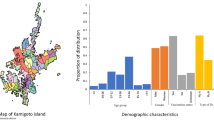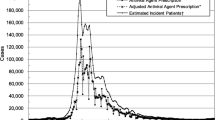Abstract
I had proposed a discrete mathematical SEPIR (Susceptible – Exposed - Pre-infectious – Infectious - Recovered stage) model for seasonal influenza. In a subsequent previously study, focusing on infections by a pre-infectious person using pre-existing data, I showed that there super-spreading of seasonal influenza occurred before D-day that the first patients are discovered at Japan Coast Guard Academy. In this study, I found that the infectivity rate from pre-infectious people is 0.041 when the surrounding people don’t take counter-measures against the infection. After D-day in the community, the countermeasures taken reduce the infectivity rate to 0.002 in working spaces and 0.013 in living spaces. And the number of infectious people can be estimated simply by the summing up each group in the community.
Access this chapter
Tax calculation will be finalised at checkout
Purchases are for personal use only
Similar content being viewed by others
Notes
- 1.
In January 2019 the freshmen had no contacts with other students and were trained by different staff.
References
CDC spread. https://www.cdc.gov/flu/about/disease/spread.htm
Iwanaga, S., Kawaguchi, K.: Analysis of epidemic of Seasonal Influenza closed space. In: Proceedings of the 22nd Asia Pacific Symposium on Intelligent and Evolutionary Systems, pp. 37–44 (2018)
Iwanaga, S., Yoshida, H., Kinjo, S.: Feasibility study on multi-agent simulations of a seasonal influenza epidemic in a closed space. In: Sato, H., Iwanaga, S., Ishii, A. (eds.) Proceedings of the 23rd Asia Pacific Symposium on Intelligent and Evolutionary Systems, pp. 203–215. Springer, Cham (2020). https://doi.org/10.1007/978-3-030-37442-6_19
Iwanaga, S.: Super-spreading is possible by the day the first patients are discovered in the community. J. Adv. Artif. Life Robot. 3(1), 24–31 (2022)
Kermack, W.O., McKendrick, A.G.: A contribution to the mathematical theory of epidemics. Proc. R. Soc. Lond. Ser. A 115(772), 700–721 (1927)
Keeling, M.J., Rohani, P.: Modeling Infectious Diseases in Humans and Animals. Princeton University Press (2008)
Simon, H.A.: The Sciences of the Artificial. The MIT Press (1996)
Author information
Authors and Affiliations
Corresponding author
Editor information
Editors and Affiliations
Rights and permissions
Copyright information
© 2023 ICST Institute for Computer Sciences, Social Informatics and Telecommunications Engineering
About this paper
Cite this paper
Iwanaga, S. (2023). A Research of Infectivity Rate of Seasonal Influenza from Pre-infectious Person for Data Driven Simulation. In: Kambayashi, Y., Nguyen, N.T., Chen, SH., Dini, P., Takimoto, M. (eds) Artificial Intelligence for Communications and Networks. AICON 2022. Lecture Notes of the Institute for Computer Sciences, Social Informatics and Telecommunications Engineering, vol 477. Springer, Cham. https://doi.org/10.1007/978-3-031-29126-5_11
Download citation
DOI: https://doi.org/10.1007/978-3-031-29126-5_11
Published:
Publisher Name: Springer, Cham
Print ISBN: 978-3-031-29125-8
Online ISBN: 978-3-031-29126-5
eBook Packages: Computer ScienceComputer Science (R0)




